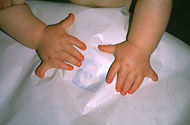Polydactyly
| Polydactyly Classification and external resources |
|
 |
|
|---|---|
| Bilateral polydactyly with short fingers in an Ellis-van Creveld syndrome patient. | |
| ICD-10 | Q69. |
| ICD-9 | 755.0 |
| OMIM | 603598 |
| DiseasesDB | 24853 |
| eMedicine | derm/692 |
Polydactyly or polydactylism (from Ancient Greek πολύς (polus) "many" + δάκτυλος (daktulos) "finger"), also known as hyperdactyly, is a congenital physical anomaly consisting of supernumerary fingers or toes. When each hand or foot has six digits, it is sometimes called sexdactyly, hexadactyly, or hexadactylism.
The extra digit is usually a small piece of soft tissue; occasionally it may contain bone without joints; rarely it may be a complete, functioning digit. The extra digit is most common on the ulnar (little finger) side of the hand, less common on the radial (thumb) side, and very rarely within the middle three digits. The extra digit is most commonly an abnormal fork in an existing digit, or it may rarely originate at the wrist as a normal digit does.
Polydactyly can occur by itself, or more commonly, as one feature of a syndrome of congenital anomalies. When it occurs by itself, it is associated with autosomal dominant mutations in single genes, i.e. it is not a multifactorial trait.[1] But mutation in a variety of genes can give rise to polydactyly. Typically the mutated gene is involved in developmental patterning, and a syndrome of congenital anomalies results, of which polydactyly is one feature.
The condition has an incidence of 1 in every 500 live births[2]. Postaxial hand polydactyly is a common isolated disorder in African black and African American children, and autosomal dominant transmission is suspected. Postaxial polydactyly is approximately 10 times more frequent in blacks than in whites and is more frequent in male children. In contrast, postaxial polydactyly seen in white children is usually syndromic and associated with an autosomal recessive transmission. One study by Finley et al3 combined data from Jefferson County, Alabama and Uppsala County, Sweden. This study showed incidence of all types of polydactyly to be 2.3 per 1000 in white males, 0.6 per 1000 in white females, 13.5 per 1000 in black males, and 11.1 per 1000 in black females.[3].


Contents |
Real polydactyls
- Hrithik Roshan, a Bollywood actor born with a supernumerary thumb on his right hand.[4]
- Antonio Alfonseca, a Major League Baseball pitcher
- During an early scene of Get Carter (the 1971 original), there is footage (in the background) of an uncredited extra grasping/holding his beer glass with five fingers.
- It is commonly believed that Anne Boleyn, second wife of Henry VIII, had this disorder, though this has never been definitively confirmed.
- Little Tich
- Hound Dog Taylor, blues guitarist
- Oneli Perez, a minor league baseball pitcher in the New York Yankees organization.
- Sid Wilson, turn-tablist in heavy-metal band Slipknot had an extra finger on each hand.
- Gary Sobers, West Indian cricketer, had an extra finger on each hand which he removed himself during childhood "with the aid of catgut and a sharp knife".[5]
- Norwegian Lundehund[6]
- Polydactyl cats
- Gemma Arterton[7], actress, had an extra finger on each hand which were removed at birth.
- Toyotomi Hideyoshi
- Natália Guimarães, Miss Brazil 2007 and Miss Universe 1rst Runner Up, was born polydactyl. Her father also had the condition and she says her eventual children would be candidates of being polydactyl, but she thinks that's no real problem.[8]
Fictional, mythological and biblical human polydactyls
- Hannibal Lecter, the fictional psychiatrist and serial murderer, had a sixth finger on his left hand. Its removal is crucial to the plot of the novel Hannibal.
- Swartt and Veil Sixclaw, fictional anthropomorphic ferrets from Brian Jacques's book series, Redwall, were both polydactyls. It was stated in the novel that Veil inherited polydactylism from his father, Swartt.
- Count Rugen, one of the villains in the novel and movie The Princess Bride, had six fingers on his right hand, by which feature Inigo Montoya was able to identify him as the man who had killed his father. Also, this made finding a good sword difficult for the count.
- Sophie Wender, in The Chrysalids, conceals that she has six toes on each foot, in a society where mutants are hunted down.
- One of the brothers of the biblical giant, Goliath, is said to have had six fingers on each hand and six toes on each foot:
- 2 Samuel 21:20
- And there was yet a battle in Gath, where was a man of great stature, that had on every hand six fingers, and on every foot six toes, four and twenty in number; and he also was born to the giant. - KJV
- 1 Chronicles 20:6
- And yet again there was war at Gath, where was a man of great stature, whose fingers and toes were four and twenty, six on each hand, and six on each foot and he also was the son of the giant. - KJV
See also
- Polydactyl cat
- Dactyly (generic term for the arrangement of digits)
- Syndactyly (digits fused together)
- Polycephaly (extra head(s))
- Polymelia (extra limb(s))
- Supernumerary body part
Additional images
References
- ↑ Polydactyly and Syndactyly
- ↑ Polydactylism FAQ
- ↑ [1]
- ↑ Hrithik Roshan Factfile
- ↑ Gary Sobers, My Autobiography, Headline, 2003, p.6.
- ↑ [2]
- ↑ Arterton's Extra Digits
- ↑ "Natália Guimarães talks about polydactyly that made her be born with six fingers", Globo.com. In Portuguese [3]
|
|||||||||||||||||||||||||